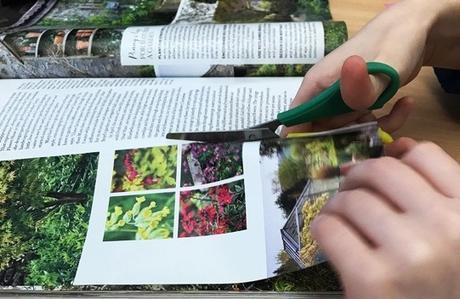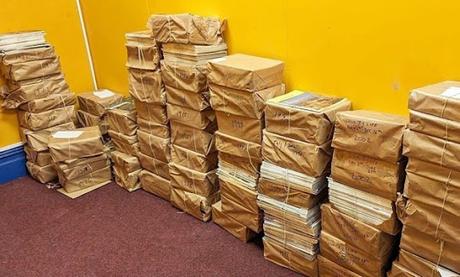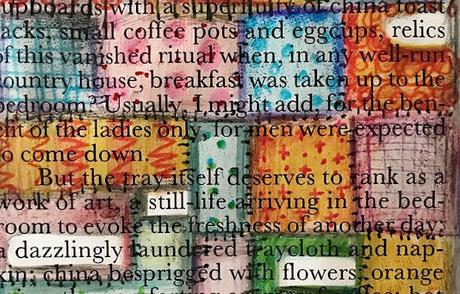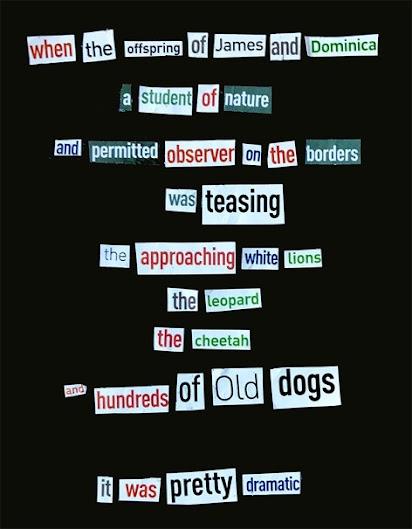
11th February 2024, Manchester Museum (Image credit: Kate Eggleston-Wirtz)
With my stash considerably depleted, I recently went on a quest to find new source material. Facebook Marketplace proved fruitful. Whilst perusing, I came across a Marketplace post selling Country Life magazines (1972–2002). Fortuitously I know David Hoyle at Lytham Heritage Group Archive Centre who posted this advertisement and contacted him straight away wondering if LHG would take an offer for a handful of the bundles (the entire lot listed at £200). He said, Yes indeed. Come next Wednesday with a shopping trolley.Off I traipsed on 14th February with my green festival trolley chucked in the car as suggested (lol), drove across town, parked up, walked the high street towing the trolley and arrived to be greeted by the leaning towers of Country Life. It was pot luck so I grabbed four bundles, had a chat, made my donation and hauled away my treasures back to their new home in the studio. At the time of this writing there are still loads left if anyone is interested. Also, the LHG Archive is well worth a visit and inspirational unto itself.
Country Life magazines (Image credit: Lytham Heritage Group)
I was excited and it didn’t take long to get creatively stuck in. Country Life December 23/30 1993, page 58 and Country Life April 28, 1994, Page 76 quickly became defaced by turning them into Blackout Poetry for the 23 February A Dead Good Blog post, ‘Blackout Poetry: Creative Development’.
detail from KEW Blackout Poetry, Dead Good Blog, 23rd February 2024
To recap from previous articles, Blackout Poetry along with Collage Poetry are forms of Found Poetry, whereby the poet finds words within text already published. Blackout Poetry leaves the words in situ as they appeared in print whilst Collage Poetry is formed from selected cut out words from a page or pages of writing/s and reassembled. In the piece below the words were cut out of a copy of BBC Magazine from July 2006.
KEW Collage Poetry, Dead Good Blog, 18th April 2022
In further investigation into Collage Poetry, also referred to as Cut-Up Poetry, I came across a quote by Bachalard (1958) that sums up this method and actually all Found Poetry quite well:A competition of surprises that stimulates our consciousness…cut-ups seem to have just this quality, taking an existing, often unpromising piece of text and transforming it into something new and worthwhile in its own right…The inspirational beauty of these different methods of Found Poetry for the writer is creating with words and phrases that may never come to mind under normal circumstances. We all have favorite words and ways of wordsmithing resulting in our own unique voices i.e. Edgar Allen Poe who often wrote in a ballad-like format vs Edward Lear who enjoyed producing nonsensical limericks.Following on from the Blackout Poetry and Collage Poetry experiments I thought I would try something different with the magazine pages. I made an attempt to combine the idea of Found Poetry and how poets traditionally create, Pulling Words Out Of The Head Poetry; this new form, at least I think it’s a new form, I have dubbed the Paragraphs Pencil Pick.Paragraphs Pencil Pick Poetry doesn’t necessarily destroy the actual magazine text - it could, but doesn’t need to. All that’s required is a piece of paper and a pencil/pen, alternatively a computer (depends on if you are old school or not), a pair of eyes for scanning and a want/need to find words that intuitively speak to the heart. The article ‘Around the Salerooms’ by Huon Mallalieu in Country Life January 27, 1994 page 66 became my go to for this exercise. The reduction/addition process is as follows:1) Choose five words from each paragraph:· name, leg, man, interesting, intriguing
· born, lived, travelled, awaiting, passage
· reached, forced, served, commander, worked
· suggested, tending, foot, peasant, began
· giving, sits, common, clothes, worn
· ascending, woman, window, watches, couple
· loving, painted, expected, oddities, laid
· cage, pair, detached, ball, saw
· globe, hinged, identify, spectacles, wanting
· called, begetter, wedding, today, paid
· included, touches, gold, box, sold
· spherical, time, price, beyond, precious
· died, firestorm, rise, battlefields, world
2) Choose one or more of the words from each line:
· leg
· travelled
· commander
· foot
· worn
· woman
· lovingly
· ball
· spectacles
· paid
· gold
· precious
· battlefields
3) Let the imagination run wild using the earmarked original words and adding other words from a place that Steve Rowland often calls the Imaginarium.
Experiment 1
I chose one word of five from each paragraph selected (see above). In the final outcome I wanted the second line of the poem to appear ‘dragging’ at the end, thus the text is aligned on the right for visual effect.
The leg traveled with its commanderdragging the mangled foot behind the worn out old womanwho stopped sat down took off her stockingto lovingly caressthe ball, heel and toeslooking through spectaclescontemplating the high price paidtouching gold, the precious commoditythat had walked battlefields
Experiment 2
I chose a second set of words, one of the five from each paragraph keeping them again in the same order as originally written, leaving out any words from paragraph six – artist’s license.
· man · awaiting · served · began · giving · expected · cage · wanting · today · time · world
Man awaiting to be served his sentence,
a word less spoken, a mouth began
giving lip service, what he expected
stuck in a cage and wanting more
than bricks and bars, today to break
out but no, break down do time,
the world no longer his, but mine.
Experiment 3
For this last experiment I chose a third set of words, two of the five from each paragraph and mixed up the order. In the end I left out nine of the 24 selected words – again, artist’s license. There are two outcomes. · firestorm · died · beyond · spherical · called · wedding · identify
· hinged · pair · saw · painted · oddities · couple · watches · sits
· common · suggested · peasant · reached · worked · born · passage
· name · intriguing
Wedding
The couple sits hinged together
cross-legged in a meditative state
the new forest as their only witness
to naked skin, evidential social cloaks
soft and supple - hard worked leather
born through the passage of privilege and a common peasant womb
entering a firestorm of tethers in time dismissed
an intriguing pair of oddities
planted equals set alight
the picture painted
miseries and
discontent
to rise
above
when
true
love
called
In the first layout I left a trail going off to the right to symbolise birth and coming out into the world. In the poem’s development, the couple appears that they will grow together like a tree, rooted in the same earth with the ‘new forest’ symbolising a new audience accepting the joining of two people from different social backgrounds.
I added the ‘new’ to help with the visual shape. As a result, I wondered how the text might work as a concrete poem in the shape of a tree rejigging some words to create an improved shape. I was pleasantly surprised with the final result.Weddingcouple sits hingedtogether cross-legged ina meditative state the forestas their only witness to naked skinevidential social cloaks soft and suppleversus hard worked leather born throughthe passage of privilege and a commonpeasant womb entering a firestormof tethers in time dismissed theintriguing pair of odditiesplanted equals setalight the picturepaintedmiseriesto riseabovewhentrue love called
Thank you for reading.
Kate J
Sources
Frances, M., 2009. Collages and cut ups – The Art of re-arrangement. Personal Construct Theory and Practice, 6. https://www.pcp-net.org/journal/pctp09/frances09.pdf Accessed 3 March, 2024.
Email ThisBlogThis!Share to TwitterShare to Facebook
